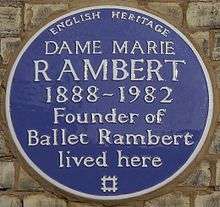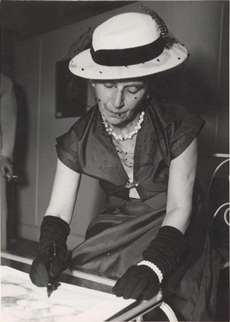Marie Rambert
| Dame Marie Rambert | |
|---|---|
|
Marie Rambert in 1948 | |
| Born |
Cyvia Rambam 20 February 1888 Warsaw, Congress Poland, Russian Empire |
| Died | 12 June 1982 (aged 94) |
| Nationality | Polish-British |
| Occupation | Ballerina and dance pedagogue |
| Years active | 1912–1979 |
| Known for | Founder of Ballet Rambert, now Rambert Dance Company |
| Spouse(s) | Ashley Dukes (1918–1959; his death); 2 daughters |
Dame Marie Rambert, Mrs Dukes DBE (20 February 1888 – 12 June 1982) was a Polish-born dancer and pedagogue who exerted great influence on British ballet, both as a dancer and teacher.
Early years and background
Born to a Jewish father from Warsaw, Congress Poland, and a Russian mother, she was originally named Cyvia Rambam. Her father and his siblings had to later change their last names for specific political reasons. Her father changed his to Ramberg, one of his brothers went to Rambert, and the last changed his name to Warszawski. She changed her name to Myriam Ramberg, and finally left it as Marie Rambert. In later years Marie was known to friends and dancers as Mim. She met her husband Ashley Dukes, a soldier on leave, at a dinner party in 1917. In Rambert's autobiography she says "after four days of personal meetings, and seven months of correspondence we were married on 3 March 1918."[1] This was done partly as a joke so that Dukes could get four weeks of extended leave instead of two days. Their marriage lasted 41 years, until he died in 1959; the couple had two daughters, Angela (1920–2006) and Helena. The poet, Aidan Andrew Dun, is her grandson.
Training
Rambert began her dance training in her schooling early on. Subjects like foreign languages and history seemed to come easy; however she was a restless child and ended up getting bad marks because of her endless movements during class. At one point in her early training her dance instructor stated that 'In her, was the true spirit of dance.'[2] She was unimpressed with the structure and performance of ballet, and was not drawn into dance as a passion until she became enthralled by Isadora Duncan when she attended one of Duncan's performances, and was 'profoundly moved by the beauty of Duncan's dance.'[3]
After becoming active in political riots, and the tragic day of May Day, Rambert's parents urged her at one point to move to Paris and take up medicine while safely living with her aunt and uncle who were also doctors. She attended a party where she danced a mazurka and danced it with such liveliness that there was applause afterwards; this was her first performance, whether she thought it or not. She met Raymond Duncan, brother of Isadora, at this same party, who congratulated her on a wonderful performance, and again she was back into her passion for dance. She studied with Madame Rat from the Paris Opera, and later studied with Émile Jaques-Dalcroze, at Dalcroze College who introduced her to eurhythmics.[4]
One day at the Dalcroze College, Sergei Diaghilev, watched a class and then asked her to come back to Berlin and study with him in the Ballets Russes. There, Rambert aided them with figuring out Igor Stravinsky's The Rite of Spring with Vaslav Nijinsky. She hesitantly accepted and collaborated with the Ballets Russes led by Diaghilev from 1912–1913. In Ballet Russes she was in the corps de ballet for ballet performances such as Swan Lake, Giselle, and Scheherazade. After a tour with Nijinsky and Ballet Russes, Rambert's contract was not continued and she decided it was time for a new chapter. In 1914 she moved to the United Kingdom, and studied under Enrico Cecchetti.[5]
Ballet Rambert

After studying with Cecchetti, she went back to study with Madame Rat at the Paris Opera, and took her studies quite seriously. She began teaching more ballet classes in 1919 and later founded her own ballet school in Bedford Gardens. In 1926 she created her own company, originally named Ballet Club. It has been through many name changes, much like Rambert herself. The company began performing at night revues in London. The first informal show was performed in Riverside Nights at the Lyric Theatre, and continued with the nightly revues for a while. She began finding new and promising dancers and choreographers in numerous places, such as Frederick Ashton, to be a part of her company and gave them a chance to grow. From Marie Rambert Dancers, the company changed to Ballet Rambert and is now called Rambert Dance Company, a modern dance company. It was the first ballet company in Britain.
The Ballet Rambert really kicked off its company performance with Ashton's A Tragedy of Fashion in 1926. Ashley, Marie's husband renovated a building and made it into Mercury Theatre, where the majority of Ballet Rambert's performance occurred. It was said that 'Notting Hill Gate, where the Mercury Theatre stood, was on the slopes of Olympus'.[6] Ballet Rambert has performed such ballets as Coppelia, as well as Balanchine's Night Shadow.
Rambert was adamant about finding new and upcoming choreographers. Some of her students and later her colleagues included Ashton, Antony Tudor, and Agnes de Mille, to name a few. In 1965 Rambert, with the help of "Norman Morrice, her newest discovery, completely reorganized the company to stress modern dance".[7] The repertoire of the company eventually came back to more contemporary ballets, but still has a vast list of pieces that the company has performed throughout the years. She cooperated with Millicent Hodson to restore Nijinsky's choreography of The Rite of Spring in 1979. The restoration of choreography was completed in 1987. Rambert is known for helping to create and keep the ballet community strong in Britain. "The creation of Ballet in Britain is one of the grandest achievements in the artistic annals of our century. It is owed absolutely to the idealism which fired Rambert and Ninette de Valois",[8] the founder of The Royal Ballet. She was the subject of This Is Your Life in 1962 when she was surprised by Eamonn Andrews at the Mercury Theatre, Notting Hill Gate.
Death
She died on 12 June 1982 and was cremated at Golders Green Crematorium on 17 June. Her ashes are within the Cloister Walk in section B.
Honours
- 1957, Chevalier of the Légion d'honneur[9]
- 1957, Queen Elizabeth II Coronation Award, presented by the Royal Academy of Dance[10]
- 1962, Dame Commander of the Order of the British Empire[9]
- 1979, Gold Medal of the Order of Merit of the Republic of Poland[9]
See also
References
- ↑ Marie Rambert, "Quicksilver: Autobiography" (London: St Martin's Press, 1972), p. 94. ISBN 978-0333347119
- ↑ Mary Clark and Marie Rambert "Dancers of Mercury; the story of Ballet Rambert" (London, A & C Black, 1962), p. 15.
- ↑ Marie Rambert, "Quicksilver", page 24.
- ↑ Nijinska, Bronislava (1981). Nijinska, Irina, ed. Bronislava Nijinska: Early Memoirs (1st ed.). New York: Holt, Rinehart and Winston. pp. 454–455. ISBN 0-03-020951-X.
- ↑ Jane Pritchard, "Rambert: A Celebration of the Company’s First Seventy Years" (London, Rambert Dance Company 1996), pp. 13–20.
- ↑ Jane Pritchard, "Celebration", p. 12.
- ↑ Jack Anderson,"Ballet and Modern Dance: A Concise History", (Princeton, New Jersey Book Company, 1986), p. 185. ISBN 0916622428 and ISBN 0916622436
- ↑ Jane Pritchard, "Celebration", p. 16.
- 1 2 3 Jewish Women Encyclopedia
- ↑ QEII Coronation Award; accessed 16 October 2016.
Bibliography
- Marie Rambert (1972). Quicksilver: Autobiography. London: St. Martin's Press. ISBN 0-333-08942-1.
- Clement Crisp (1981). Ballet Rambert: 50 Years and on. London, Ballet Rambert. p. 111. ISBN 0-9505478-1-6.
External links
- Marie Rambert's appearance on This Is Your Life
- Marie Rambert Collection, 1890s–1980s
- London Gazette notice of damehood for Marie Rambert, Mrs Dukes (1962); accessed 17 May 2014.

